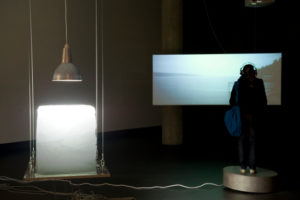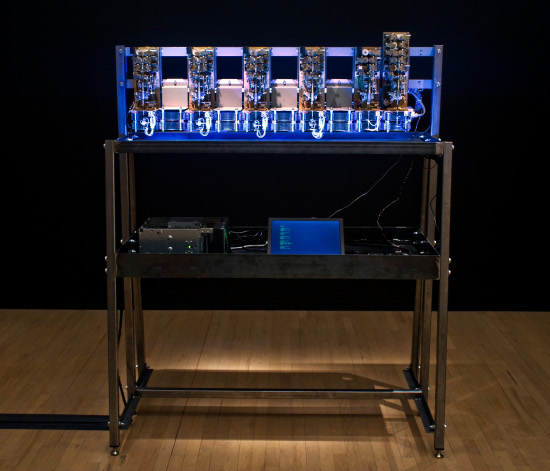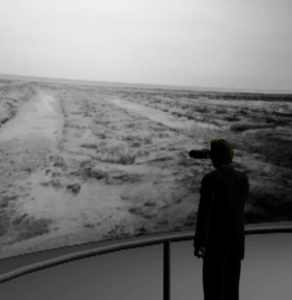



Having attended some of the exhibition events at Transmediale.09 Deep North, in Berlin over the weekend of 29th January to 1st February this year I write this article from the departure lounge of the Berlin Schonenfeld airport. A blast of cold arctic weather has enveloped the UK, leading to the cancellation of all flights in and out of Stanstead airport and provided me with some down time in which to reflect on the festival.
Transmediale.09 Deep North purports to construct an impression of the polar regions as a place that can be “imagined but never truly captured”. In seeking to move beyond prevailing notions of catastrophic environmental change and to examine its broader cultural consequences, the festival aims to adapt and explore creative technologies and point the way to political transformation and creative sustainability. Such lofty ambitions are commendable though how attainable they are through the engine of an arts festival remains to be seen. Furthermore the festival organisers can be in no doubt of the irony that the success of their event is largely predicated on the numbers of media arts professionals flying in from across Europe to consider such issues, and as such anyone making too strong an argument for political and social action might be construed of as a little hypocritical.
If the festival sets itself philosophical objectives that are difficult to achieve, then the works exhibited around Berlin as part of the event stand or fall on their own individual merits, their abilities to provoke thought and reflection, while the exhibitions in which they are showcased must provide a context for there inclusion and a link to the wider aims of the festival.
The main site at The House of World Cultures in the Tiergarten has been transformed into a “makeshift zone of cultural shelter” by the Berlin design group raumtaktik. Different works occupy the buildings foyer, some of its anterooms and it’s main exhibition space. The gallery charged a five euro fee for entry, while works in other parts of the building were freely accessible. There were guides on hand in all areas, but while most were helpful and allowed photography this was strictly limited to accredited press at the paying show. Whatever the intention was, this practice produced a hierarchical construct, with the works within the boundary of the paying show being effectively corralled off from those outside and thus somehow being given an authoritative stamp.
Overall the works exhibited in the paying show were less interesting than those displayed outside. This was with the exception of Jan-Peter E.R. Sonntag’s Amundsen / l-landscape (which I was unable to photograph). This work required you to stand on a podium and don a pair of headphones while watching a video projection of a rain spattered watery scene. The footage for this was shot in Norway close to the home of Amundsen, the famous polar explorer. another aspect of the same exhibit was a huge block of ice, sitting on a board suspended from cables in space and illuminated by a heat lamp. Sensors fitted into the board picked up data from the melting block and this was digitised and fed-back to the viewer via their headphones. The ice produced the sound of a deluge, the soundtrack to the film making our experience of the whole work simultaneously deeply mediated and intensely poetic.

Jan-Peter E.R. Sonntag – AMUNDSEN / I-landscape (de, 2009). Photo: Jonathan Granger
Other works within the House of World Cultures but outside the paying exhibition that were of note included; Harwood, Wright and Yokokoji’s Telephone Trottoire, a project which enables the worldwide Congolese community to reformulate a form of traditional communication via networked technology. The work, which won this years jury prize had a material, almost sculptural quality, made manifest through its use of redundant analogue telephone exchange equipment. “For ‘Telephone Trottoir’, we recorded twenty short monologues or clips focusing on life both in the UK and back home in the DRC. These clips were intended to pose questions, impart information, highlight factual events, and to provoke the listener into making a comment or just to think about their lives and the future of the Congolese community in the UK. All stories and dialogue were recorded and played back in Lingala/French, which meant that listeners were much more inclined to accept the calls and participate in the project.”[1]

Graham Hardwood, Richard Wright, Matsuko Yokokoji (uk) Telephone Trottoire -Tantalum Memorial (2008)
Petko Dourmana’s Post Global Warming Survival Kit is an installation inviting the audience to explore it in a darkened space with night vision headsets. Ready to be discovered inside the space were projections of a bleak, featureless landscape and a small mobile caravan which you were able to enter and survey. Set up as an imaginary post apocalyptic world in which human vision has adapted to the nuclear winter, the experience of the work is deeply unsettling, requiring the audience to use their sense of sight to somehow ‘feel’ their way around the space. “Confrontation with the bare necessities for survival provided by Dourmana quickly makes viewers aware that more is needed than mere material goods to ensure emotional survival as well. In his post-apocalyptic world, Dourmana allows viewers to experience other visual worlds or aspects of our reality that are invisible without the aid of high-tech devices. Without technology, we would be blind in his world.”[2]

Petko Dourmana – Post Global Warming Survival Kit. Photo: Petko Dourmana
There are of course many other partner organisations involved in a festival as large as this, with many other workshops and exhibitions taking place at fringe venues and it is here that much of the more interesting experimentation takes place. Club Transmediale in particular offered interesting content, with groups such as Bank of Common Knowledge providing inspirational support to those interested in collaborative production practices and soundmuseum.fm an audio repository.
The Collegium Hungaricum Berlin, another partner venue in the festival provides a site for an ambitious architectural project. Corpora In Si(gh)te Architecture as an environmental, spatial measuring machine presents several projected video screens that map in real-time the flows and eddy’s of air currents around the building. Data is gathered through a mesh network set up in the vicinity of the building and presented within it as a form in a state of constant flux.
In the UK the weather used to be a safe subject for conversation, people could discuss it without the need to make cultural references, and thus revealed little about themselves, or their backgrounds, it was a subject upon which you were allowed to disagree. All this has changed, as global warming becomes climate change, the traditional late January cold snap for which we are totally unprepared takes on other overtones. While on the one hand there is a temptation to dismiss much of what is argued as our effect on the planet as humanist arrogance, the ethical questions of how we behave and act still require more exploration.
I am now stranded at Dublin airport en rout to the UK, the battery on my laptop about to give out, while an almighty snow storm rages across Western Europe. At times like this The Deep North seems much less an abstract concept and much more a hard reality, to be weathered, and dealt with as best we can, as we are jolted out of our everyday lazy reliance on our global communications infrastructures and our perceived ability to somehow exist outside of ‘nature’ is distinctly thrown into question.
[1]WHY TELEPHONE TROTTOIRE?
http://www.tantalumexploration.net/pages/trottoirehistory.php
[2]Text by Sabine Himmelsbach Artistic Director of Edith Russ House for Media Art.
http://www.dourmana.com/node/104